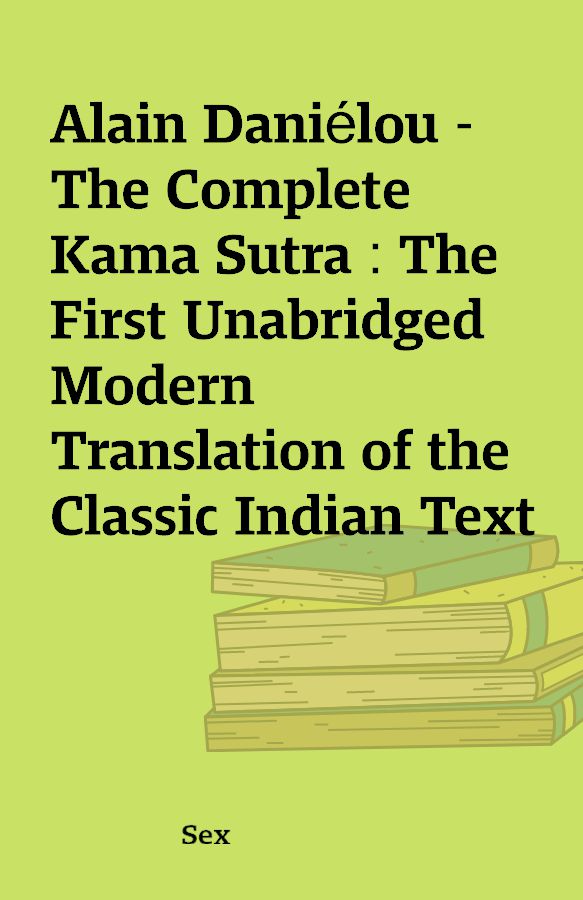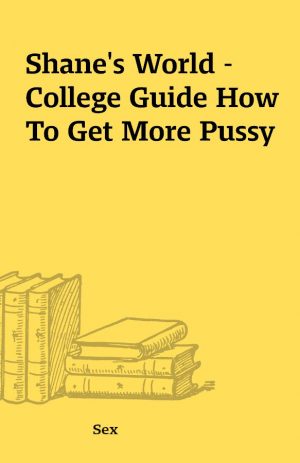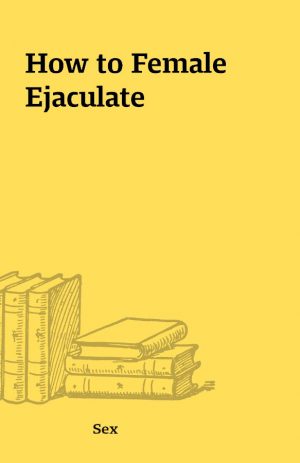Alain Daniélou – The Complete Kama Sutra : The First Unabridged Modern Translation of the Classic Indian Text
Danielou – Complete Kama Sutra.pdf
[1 eBook – PDF]
Description
The Complete Kama Sutra : The First Unabridged Modern Translation of the Classic Indian TextBy Alain DaniélouPublisher: Park Street PressNumber Of Pages: 564Publication Date: 1994-01-01ISBN-10 / ASIN: 0892814926ISBN-13 / EAN: 9780892814923Product Description:This definitive volume is the first modern translation of Vatsyayana’s Kama Sutra to include two essential commentaries: the Jayamangala of Yashodhara and the modern Hindi commentary by Devadatta Shastri. Alain Danilou spent four years comparing versions of the Kama Sutra in Sanskrit, Hindi, Bengali, and English, drawing on his intimate experience of India, to preserve the full explicitness of the original. I wanted to demystify India, he writes, to show that a period of great civilization, of high culture, is forcibly a period of great liberty. “Danielou’s new and complete translation of ‘The Kama Sutra’ is one of his masterpieces. It is all enchantment, a world of refined sensation. Our debt to his scholarship and humanity is immeasurable.”What Exactly is the Kama Sutra? The Kama Sutra is a sex-education textbook that was penned by the Indian scholar Vatsyayana in the 4th century A.D. Despite its age, the Kama Sutra remains one of the most comprehensive works on love and eroticism to date. Contrary to popular belief Vatsyayana’s masterpiece is not a pornographic how-to manual, but rather it is a thorough analysis of the nature of love, sex and intimacy. It is mostly in Western cultures that his work has been misrepresented and sensationalized through illustrated versions of the text and films like Penthouse’s Kama Sutra Pleasures. While the Kama Sutra is explicit in parts, it is suprisingly intellectual in nature. The Underlying Ideology: Revisiting the Aims of Life The three aims of life have been reported as artha (material goods), dharma (morality) and kama (eroticisim). Initially described separately (Artha Shastra, Dharma Shastra and Kama Shastra), Vatsyayana merges the interrelated aims into a single work with an emphasis on eroticism (kama). Without material goods (artha) such as food and shelter, the body cannot survive to perform the additional aims of life. Erotic practice (kama) fuels the spirit that drives an otherwise hollow vessel. Finally, the first two aims must be attained using ethics (dharma) as a moral compass to avoid empty successes. Since his manual is a synthesis of ideas, Vatsyayana never presented the Kama Sutra as an original work — but rather as a compilation and impartial examination of existing ideas. The Target Audience For whom did Vatsyayana write the Kama Sutra? As I’ve already indicated, the Kama Sutra was written as an educational text. Vatsyayana intended for his work to be read by teenagers prior to the initiation of erotic practice. So it would appear that the Kama Sutra is an ancient sex-ed manual, which includes courting rituals and marital unions. Today, the Kama Sutra can serve as a useful reference for anyone with an interest in sex and love. Upfront Answers to Your Burning Questions Does Size Matter? YES. According to Vatsyayana, the size of sexual organs does matter. However, it is the size of both the man AND the woman that determine an ideal union. Men are said to be of three sizes: Hare (shasha), Bull (vrisha) and Stallion (ashva). Likewise, women are also said to be of three varieties: Doe (mrigi), Mare (vadava) and Cow-elephant (hastini). Ideal unions occur between a man and a woman of similar size, but the pairing of extremes is strictly forbidden. I found it quite interesting that the concept of ‘size’ has been contemplated for so long. Perhaps that Vatsyayana is a man is the reason he split the burden of size between both men and women. (CAUTION: If a woman insults a man’s size I do not recommend any references to a cow-elephant without first ducking.) Are There Really 69 Sex Positions Described? NO. The idea that the Kama Sutra details 69 sexual positions is an urban myth that is probably responsible for the book’s sordid reputation. While the text does describe many sexual positions, they do not number 69. Most of the Kama Sutra is dedicated to the means of obtaining a partner and foreplay rather than to the actual act of intercourse. Vatsyayana does discuss the 64 erotic arts (sometimes termed ‘positions’) as essential preludes to sex, although he did not imagine these himself. Among other things, the 64 erotic arts include kissing, caressing, embracing and hitting. Are There Dirty Pictures? NO. The original Kama Sutra was not illustrated; however, many contemporary versions contain authentic reprints of erotic Indian artwork from the time of Vatsyayana. I won’t lie to you, there are certain discussions where an illustration would be extremely helpful. Sorry folks, there is no hardcore porn here. The Translation The Complete Kama Sutra is an unabridged version of the Kama Sutra translated by Alain Danielou. Danielou’s intent was to preserve the explicit details contained within the original text. The majority of modern publications rely on the 1883 translation of Sir Richard Burton, which is highly censored and excludes subsequent annotations. With respect to completeness, Danielou’s translation is considered superior to Burton’s. This is an important factor when considering which edition to purchase. Writing style Danielou’s translation preserves the integrity of the original text by maintaining the verses in condensed format (sutra). This allows the reader to absorb the information as Vatsyayana had originally intended. While the text is comprehensive, it is the annotations that compose the majority of the unabridged volume. The Kama Sutra is written in a relatively impartial manner, speaking in terms of society’s expectations and beliefs. When Vatsyayana interjects a personal opinion, he refers to himself in the third person. This can be confusing at times even though the annotations are clearly separated from the original text. The Annotations The Complete Kama Sutra also includes the annotations of Yashodhara and Devadatta Shastri, rendered in different fonts so that the source is readily identifiable. The annotations are often redundant; however, there are many times when they are essential to understanding the meaning of Vatsyayana’s original commentary. Rather than revising and releasing new editions of a text as we do today, it was tradition to keep the original text intact and append any additional notations or clarifications. Unless necessary for understanding, I recommend skimming the annotations since they can be quite lengthy at times. Overall Readability Danielou’s translation is clear and crisp. Each verse of the Kama Sutra and every paragraph of annotation can be readily understood. However, I still do not recommend reading The Complete Kama Sutra cover-to-cover as I have done. Having read Danielou’s translation twice, I must constantly refer back to the text to refresh my memory. Thank goodness for the Index. There is too much information to make a cover-to-cover reading worthwhile. I encourage anyone interested in the Kama Sutra to focus on the chapters of interest since many do not need to be read sequentially. It is a textbook, so treat it as a reference rather than a novel. The Contents The Kama Sutra is written in seven parts with each part containing several chapters. I will briefly discuss the contents of each part because the text is too broad to summarize adequately. Part I: General Remarks The first part is an introduction to the Kama Sutra and the importance of studying its contents. Vatsyayana also offers some commentary on the three aims of life and the behavior of people in general. Part II: Amorous Advances Vatsyayana starts with a discussion of sex size and follows with a systematic dissection of the art of seduction. Vatsyayana discusses embraces, petting, caresses, scratching, biting, blows (hitting), sighs (moaning), fellation (oral sex), sexual positions, masculine behavior in women (primitive dominatrix) and special interests (sodomy, homosexual behavior, dildos). Undeniably the most graphic, ‘Amorous Advances’ is also the most interesting part of the entire text. While I didn’t come across anything revolutionary, I was fascinated to read such a pragmatic examination of explicit behavior. Part III: Acquiring a Wife Vatsyayana moves on to explore the means of attaining a wife. Discussed are the types of encounters, intermediaries and marriages. ‘Acquiring a Wife’ begins the portion of the text that shows its age. The women of Vatsyayana’s time enjoyed more freedom than in the centuries to follow, but they were still largely regarded as property. At times Vatsyayana seems to favor the independence of women, but at others offers support to the contrary. He suggests that a marriage by choice (gandharva) is ideal, but that more traditional marriages arranged by families through the exchange of property (Brahma) are more ethical and well-omened. I can’t help but feel that Vatsyayana was a true romantic that recognized the pressures of society and tradition. Part IV: Duties and Privileges of the Wife In only two chapters, Vatsyayana discusses the roles of the primary wife and other wives. The role of the woman seems to be in pleasing her husband through chores, words and intimacy; again showing the works age. While additional wives (a harem) are not necessarily recommended by Vatsyayana, they are allowed when a woman is infirtile, stupid or because the man has become bored. Part V: Other Men’s Wives Vatsyayana prefaces the fifth part by discouraging fornication with another man’s wife. With his warnings out of the way, Vatsyayana proceeds to detail the means of arranging an encounter, the use of intermediaries, the interpretations of behavior and the methods of seduction. Vatsyayana also discusses the gynoecium (harem) at length. Part VI: About Courtesans The penultimate chapter describes the behavior and mannerisms of prostitutes, defined as those who trade sex for personal gain. Vatsyayana approaches the subject with much tact, carefully observing the pros and cons to the lifestyle of the cultured and illiterate prostitute alike. The courtesan is held with the highest regard, as much for her culture and beauty as for her sex. Part VII: Occult Practices Only when all else fails does Vatsyayana recommend turning to the practice of magick. In the chapter ‘Success in Love’ he teaches us of rituals and ointments that will enhance our sex-appeal. In the chapter ‘Arousing a Weakened Sexual Power’ he explains how to cure erectile dysfunction (impotence) and fashion primitive sex-dolls and other toys. Want to know more? You’ll have to buy the book. Appendices The appendix includes additional information about works cited, historical references and a glossary of terms and botanicals. Boy, was this guy anal! Completeness I have to give Vatsyayana mad props for undertaking such an ominous task with true style. Such a thorough and pragmatic discussion of love and intimacy might seem impossible, but I assure you that no topic is left untouched. Only when Vatsyayana presents an opinion is one able to gauge his personal feelings, a testament to his impartiality. I must also give a shout out to the late Alain Danielou, whose precision and patience in translating a 1600 year old text have allowed me a truly enlightening experience. The Ebb and Flow of Time No scruples are needed with women who have already been used by someone else. [Part I, Chapter 5, Verse 7] With phrases such as these, it becomes apparent that there are many similarities between the world today and in the time of Vatsyayana. However, I don’t believe that attitudes have remained stagnant over the last 1600 years. Rather, I believe that they are in a constant flux. The philosophy of Tantra places women as the superior gender, supporting my ebb and flow hypothesis. It just happens that the mind-set of Vatsyayana’s time approximates that of today. An interesting retrospective, indeed. Final Comments I’ve said more than I should have, but not quite enough to do the Kama Sutra justice. More interesting as a historical text than an educational manual, the Kama Sutra still promises to be an enlightening experience. You can’t go wrong with Danielou’s unabridged translation of THE pioneering work on sex. Similar Works: There Ain’t Nothing Like It.
You must be logged in to post a review.






Reviews
There are no reviews yet.